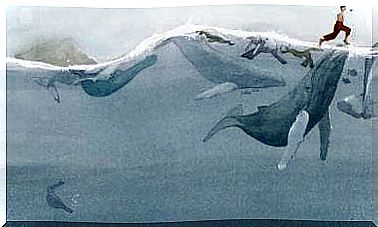Cognitive Fusion: If We Are What We Think

Cognitive fusion (FC) is a psychological phenomenon in which the boundary that separates us from our thoughts dissolves. That is to say, we begin to believe that we are what we think, or that what we think absolutely corresponds to reality.
This thought pattern can lead to profound malaise, so it’s important to learn to distance yourself from everything we think about. For what reason? Because thoughts are very often distorted, irrational or illogical. Reality and identity go far beyond what we think.
What else do we know about this concept? How can we counter it? In the last part of this article we will present a simple exercise that can help you step away from cognitive fusion little by little.
Cognitive fusion: when we are what we think
Cognitive fusion (FC) is defined as the union that occurs between what we think and what we believe we are; it literally means to merge with one’s thoughts. That is to say that in this phenomenon two elements are mixed: thought and mind (or consciousness itself and the interpretation of reality).
Hayes et al. (2011), cited in an article by Ramos et al. of 2018, have elaborated a very precise definition of this concept, stating that cognitive fusion could be defined as “that tendency to believe in the literal content of thought and feeling”.
As well as “an excessive or improper regulation of behavior through verbal processes (rules), rather than through the contingencies of the context”.

Perceiving thought as reality
When we express our involvement in the phenomenon of cognitive fusion, we do not distinguish between what we think and the conditions that give rise to these thoughts.
So here we tend to conceive thought as absolute and immovable truth: “I think this, therefore I am this”, or again: “if I think this, then this is the reality”.
With cognitive fusion we forget to compare our thinking and the objective reality from which these thoughts arose.
Throughout this process we find it hard to take a stand on our personal thoughts, because we merge into them.
The impact on behavior
This thought pattern prompts us to take literally the thoughts that crowd our minds. And all of this has a strong impact on our behavior.
So, little by little we end up aligning our behavior with those thoughts, as if they represented the only truth or the only possible reality.
An example of cognitive fusion
To better understand the concept of cognitive fusion we will focus on an example. Imagine that someone has had a panic attack in the middle of the street and it has particularly distressed them. He manages to calm down a little and, therefore, returns home.
Then the next day, that same person comes down the stairs to leave the house and starts thinking: “I’m sure I’m going to have another panic attack. Can’t you see I’m starting to shake? “.
Without realizing it, the person in question assimilates this thought, accenting it as true, as something that is absolutely part of his own reality. So, in the end he decides to go back home. That’s what cognitive fusion is.
Examples that concern ourselves and others
This is just an example of cognitive fusion, but we could find many others: those that have to do with their own person, with external circumstances, with others, etc. However, all these examples have one thing in common: the fusion of personal thought with reality.
Cognitive defusion to combat cognitive fusion
That of cognitive defusion is a technique that is part of some applications of psychotherapy, as in the case of acceptance and commitment therapy.
It is actually one of the core elements of the ACT. A fundamental aspect of this type of therapy is being able to interpose a certain distance between the person (ie the patient) and his thoughts. How do you do it?
By making sure, for example, that the patient realizes that thoughts are often not reflected in reality or that they are only thoughts (words, or rather, sounds) and not what they pretend to be.
To apply the technique of cognitive defusion, it is possible to resort to various experiential exercises, with the aim of inducing the patient to act independently of what his mind tells him to do.
Cognitive defusion to encourage acceptance
As in other types of therapies, also in acceptance and commitment therapy (especially in the case of certain disorders), acceptance is a key element.
Accepting pain, experiences, everything we feel… and this acceptance can be reached more easily, thanks to the process of cognitive defusion.
For what reason? Because cognitive defusion changes the consideration of internal events and, moreover, acceptance helps to free oneself from these same events.

Do this exercise: “see the clouds go by”
To stimulate the process of cognitive defusion, various exercises are usually practiced, including, for example, the so-called “observation of passing clouds”.
This exercise consists in helping the patient to find out if his thoughts and discomfort are like gray clouds in the sky, but they are not the sky, although sometimes they can cover it for days and it is better to stay and observe them waiting for them to pass.
Concluding remarks
Cognitive fusion affects many people, regardless of whether or not they have a mental illness.
It can interfere with personal well-being, which is why it is important to become aware of what is happening to us, if it is what is happening to us, and to work on it.
Cognitive defusion is one of the techniques most often used to intervene on this model of thought, although each therapeutic technique makes use of its own tools, in order to encourage us to distance ourselves from our own thinking.









